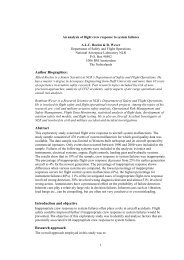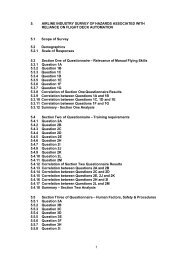Causal risk models of air transport - NLR-ATSI
Causal risk models of air transport - NLR-ATSI
Causal risk models of air transport - NLR-ATSI
Create successful ePaper yourself
Turn your PDF publications into a flip-book with our unique Google optimized e-Paper software.
are those that are not immediately apparent but manifest themselves some time after the<br />
accident. Examples <strong>of</strong> indirect effects are health problems <strong>of</strong> rescue workers caused by<br />
exposure to toxic substances, or the development <strong>of</strong> post traumatic stress disorders among<br />
people that have witnessed or were involved in <strong>air</strong>craft accidents. The manifestation and<br />
degree <strong>of</strong> indirect effects is largely governed by social, psychological and epidemiological<br />
factors and requires different knowledge and expertise than estimating direct <strong>air</strong>craft crash<br />
effects.<br />
2.2. Risk perception<br />
The definition <strong>of</strong> safety in the previous section introduces acceptability <strong>of</strong> <strong>risk</strong>.<br />
Acceptability <strong>of</strong> <strong>risk</strong> is strongly influenced by <strong>risk</strong> perception. The level <strong>of</strong> perceived <strong>risk</strong><br />
has been found in several studies to be dependent on the degree to which people believe<br />
that <strong>risk</strong> can be controlled and by whom, trusted or not [Slovic et al 1976, Hale & Glendon<br />
1987]. Voluntary and involuntary exposure to <strong>risk</strong> is also a main driver for <strong>risk</strong><br />
acceptability (Figure 2). Another factor that is related to <strong>risk</strong> perception and the level <strong>of</strong><br />
accepted <strong>risk</strong> is the chance <strong>of</strong> multiple fatality accidents [O’Banion 1980, ETSC 1997]. A<br />
fourth factor that plays a role is the time passed since a similar event took place. The more<br />
retrievable the event, the greater its intuited probability. News media’s extensive coverage<br />
<strong>of</strong> <strong>air</strong>craft accidents make them particularly ‘retrievable’. For instance in a 1996 Associated<br />
Press survey, U.S. newspaper editors and television news directors said that the Trans<br />
World Airlines Flight 800 accident 5 was the ‘biggest’ news story <strong>of</strong> 1996 [Barnett & Wang<br />
2000]. A 1990 study <strong>of</strong> page-one newspaper articles regarding fatalities in the United States<br />
said that coverage <strong>of</strong> <strong>air</strong> carrier accidents in The New York Times was 60 times greater than<br />
its coverage <strong>of</strong> AIDS, 1,500 times greater than coverage <strong>of</strong> automobile-related hazards and<br />
6,000 times greater than coverage <strong>of</strong> cancer [Barnett & Wang 2000]. Events that result in<br />
‘identifiable’ victims have more impact than events resulting in anonymous or ‘statistical’<br />
victims. An accident, such as an <strong>air</strong>craft crash, therefore has more impact on public<br />
perception than for instance exposure <strong>of</strong> large and hence anonymous populations to toxic<br />
substances due to general environmental pollution [Health Council <strong>of</strong> the Netherlands<br />
1999].<br />
As <strong>risk</strong> implies possible loss, <strong>risk</strong> perception is also a direct reflection <strong>of</strong> perceptions <strong>of</strong><br />
value [Brauer 2004]. As such, there are differences in <strong>risk</strong> perception across cultures and<br />
across time. Accidental death is likely to be more acceptable (to society as a whole) in<br />
regions where the life expectancy is lower than the world average due to ‘natural’ causes <strong>of</strong><br />
death such as infectious diseases and famine. A comparison <strong>of</strong> <strong>air</strong>craft accident rates and<br />
gross domestic product across world regions indeed show a strong inverse relation [Roelen<br />
et al 2000c, Visser 1997]. Likewise <strong>risk</strong> acceptability depends on the benefit associated<br />
with <strong>risk</strong> exposure. The greater the reward, the higher the <strong>risk</strong> we are willing to take.<br />
5<br />
On 17 July 1996, Trans World Airlines Flight 800 crashed minutes after take <strong>of</strong> from John<br />
F. Kennedy International Airport, New York. The cause <strong>of</strong> the accident was an explosion <strong>of</strong><br />
the centre wing fuel tank. The source <strong>of</strong> ignition energy for the explosion could not be<br />
determined with certainty, but, <strong>of</strong> the sources evaluated by the investigation, the most likely<br />
was a short circuit outside <strong>of</strong> the centre wing tank that allowed excessive voltage to enter it<br />
through electrical wiring associated with the fuel quantity indication system [NTSB 2000].<br />
13




